This collaborative project was developed to foster Indigenous Traditional Owner and Elder assessments of wetland health on Bardi Jawi Country in the Kimberley region of north-western Australia. The project was led by the Bardi Jawi Rangers (men’s and women’s teams) and Traditional Owners and Elders, working with a range of collaborators including University of Western Australia hub researchers, Environs Kimberley (the peak environmental organisation for the Kimberley) and a Māori researcher dedicated to developing wetland health assessments by Māori iwi (tribes).
This action-research project developed and implemented a wetland monitoring program within the context of Healthy Country Planning, the method adopted by most Kimberley Indigenous ranger groups to plan, implement and review Ranger work. More than a decade ago, as a part of developing their Healthy Country Plan, Bardi Jawi Elders chose traditional oola places as an important part of Country to look after (one ‘target’). Elders also identified ‘attributes’ of traditional oola places (the main things used to identify health of a ‘target’) and related indicators (things that can be measured to give information about attribute viability or health). Using a range of methods and supported by collaborators, Bardi Jawi Rangers and Elders re-visited and validated the attributes and indicators, chose 3 traditional oola places to monitor, identified how the attributes relate to each oola place, trialled techniques for measuring indicators and, finally, commenced monitoring.
Attributes reflect how Bardi Jawi belonging, presence and active traditional use are a part of wetland health and include:
- knowledge of sites and stories (especially of young people)
- community members respectfully use and benefit
- surrounding plants (related to historical condition and how places support use)
- water quality (for drinking or swimming)
- amount of water (related to historical condition and how places support use).
Drawing on work conducted with Māori people, the project also highlighted the importance of Indigenous peoples’ memory and historical knowledge in understanding wetland function and health. Rangers interviewed Traditional Owners and knowledgeable Elders to find out how traditional oola places looked and functioned in the past, using these memories to reflect on the current condition of attributes and to inform how they would like attributes to be (desired condition). Thinking about attribute change and condition also helped to decide on, or confirm, the indicators to measure to give information about attribute change over time. These indicators form the basis of the monitoring program, with indicator information recorded using a digital form (Fulcrum) by rangers during twice-yearly visits to the traditional oola places.
A key aspect of the project was trialling ways of communicating about the monitoring, including how the monitoring has been set up and what the monitoring is telling Bardi Jawi people about attribute health. One Bardi Jawi Ranger (Trevor Sampi) created artistic representations of the historical state of one traditional oola place and of the 5 attributes monitored across sites. Using the artwork and photos, project staff developed a visual guide to express monitoring methods and findings, as a tool to support ongoing monitoring by the rangers and inform management actions, and to communicate with the broader Bardi Jawi community (see below).
Management recommendations have arisen from the monitoring, with priorities including education about safe use of traditional oola places for drinking and swimming, teaching young people about the history of places and family connections, and, at 2 places, ideas to remove plants that are out-of-place and improve water quality.
The project:
- operationalised Bardi Jawi attributes and indicators of traditional oola place health within a monitoring program that informs management activities
- developed a visual guide to be used by the Bardi Jawi Rangers when conducting monitoring and to share with the broader Bardi Jawi community
- achieved several strategies within the Bardi Jawi Indigenous Protected Area Management Plan (Healthy Country Plan)
- contributed to processes that elevate Indigenous knowledge in planning and implementing wetland monitoring and informing wetland management.
This project was funded by a University of Western Australia Research Collaboration Award, Lotterywest and the Bardi Jawi Rangers, with additional support from the Australian Government under the National Environmental Science Program’s Resilient Landscapes Hub. The Bardi Jawi Rangers are supported and managed by the Kimberley Land Council.
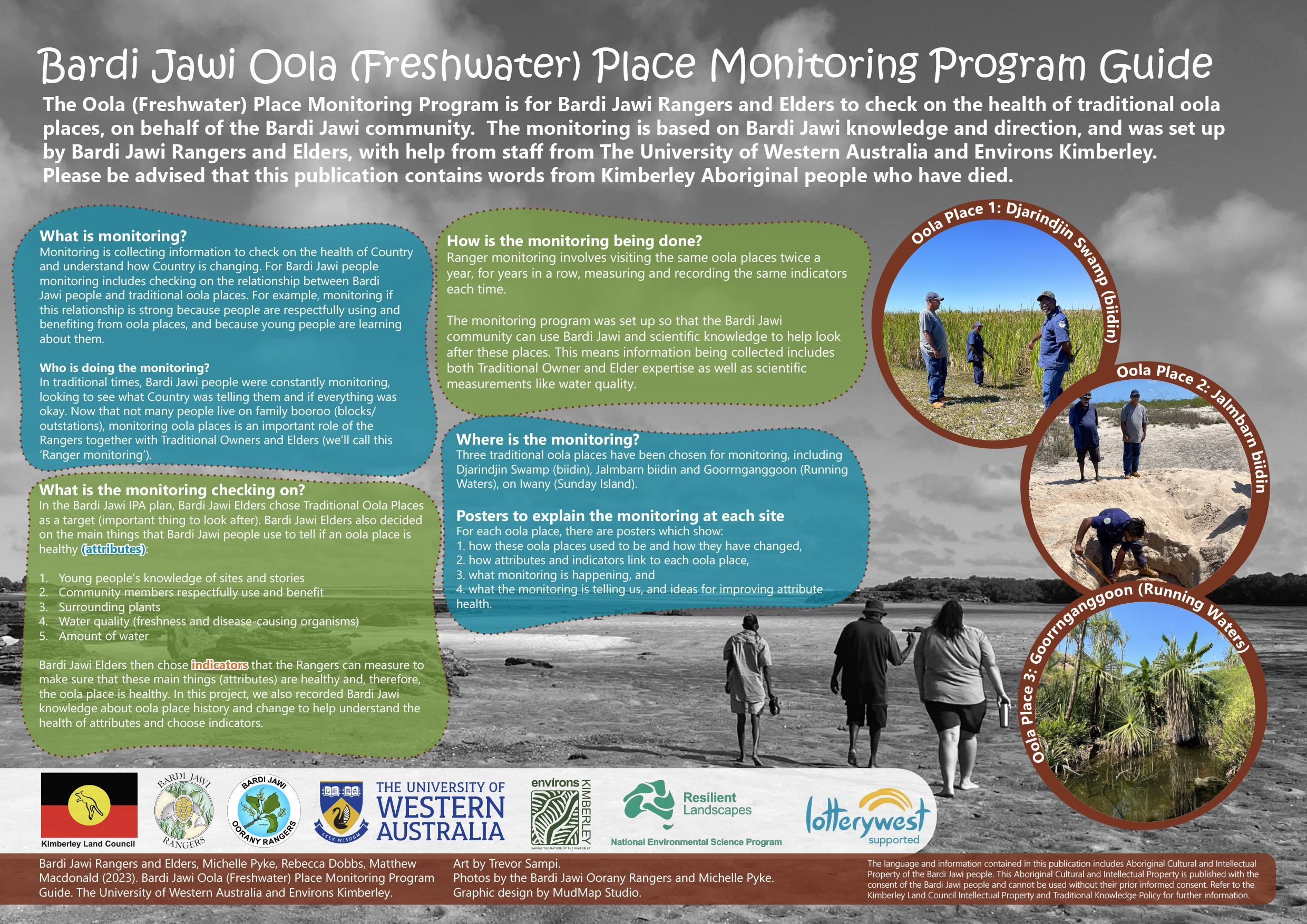
The monitoring guide title page gives some background to the Healthy Country Planning steps and terms and introduces the 3 traditional oola places to be monitored. Monitoring information for each traditional oola place is then expressed across at least 4 posters (pages). As an example, the visual guide (posters) for one traditional oola place, called Jalmbarn, is included below with permission from the Traditional Owner family.
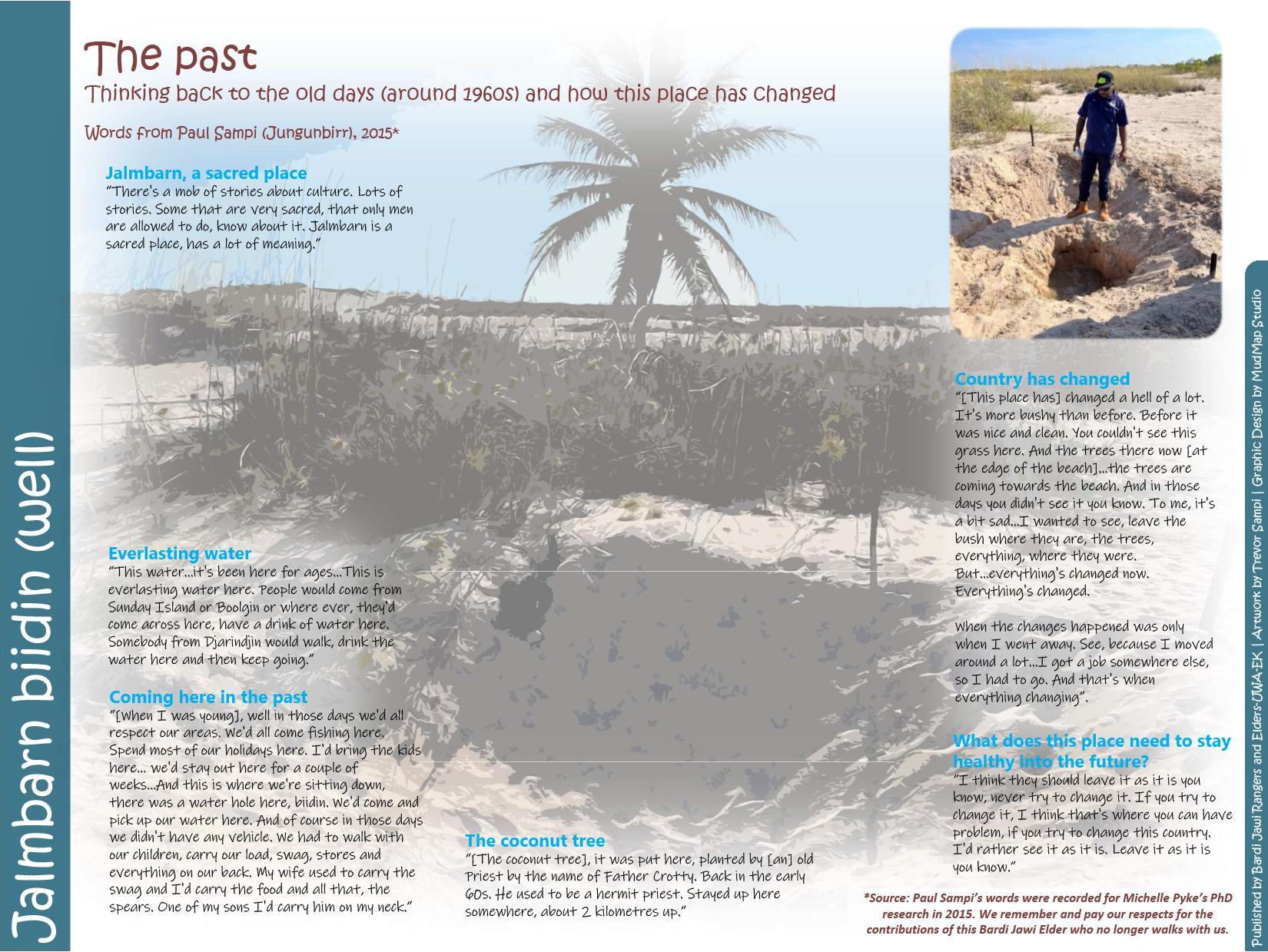
The poster set for each traditional oola place begins with a poster about the history and meaning of that place, based on Bardi Jawi knowledge. This poster might include Traditional Owner or Elder memories from their youth, explanations of how the place has changed, what people used to do there and what Traditional Owners and Elders may wish for this place.
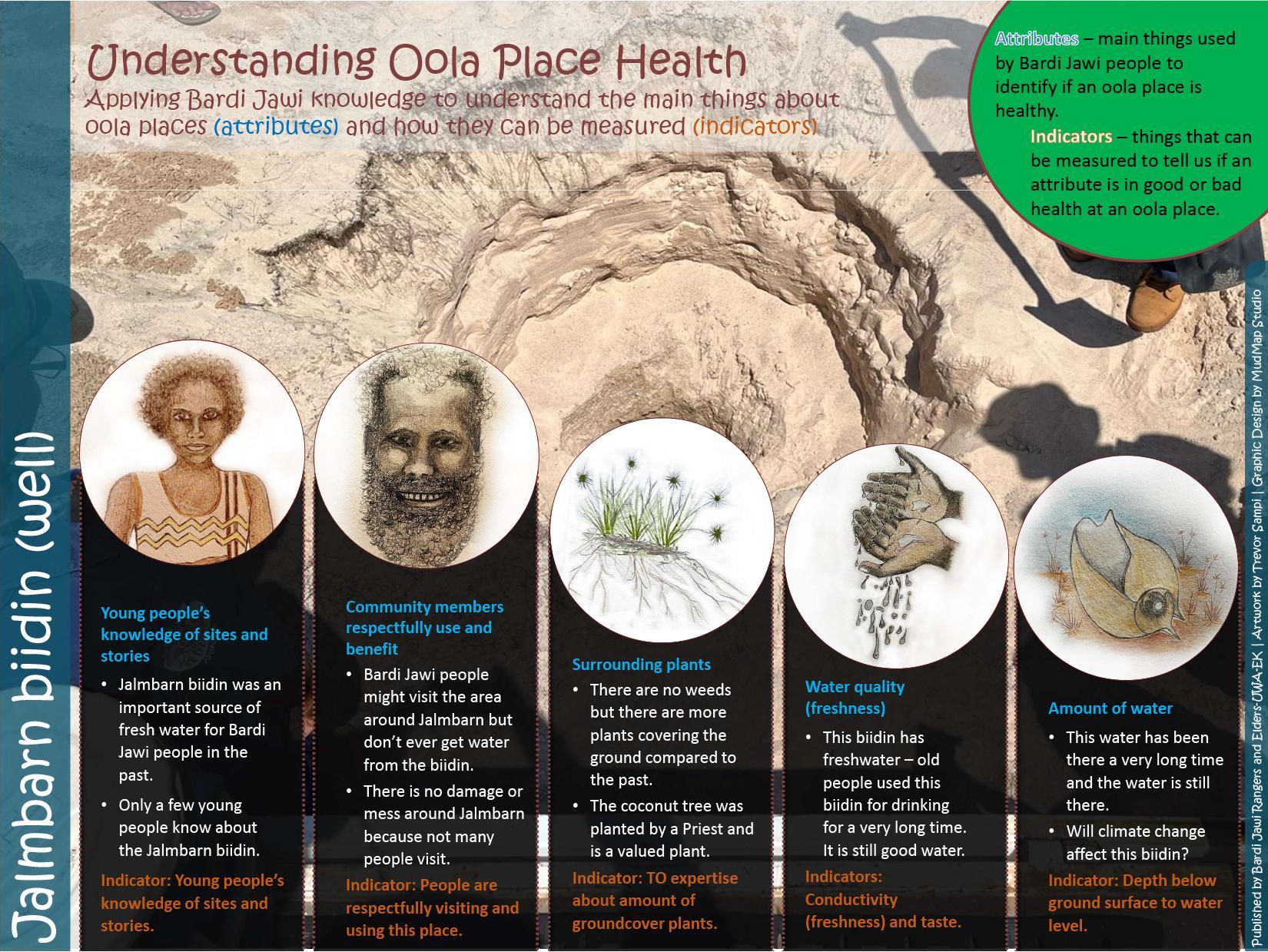
The second poster specific to each traditional oola place summarises the condition of each attribute based on Bardi Jawi knowledge for that place. It also outlines the indicator(s) chosen to measure attribute condition, which were chosen by Bardi Jawi people.
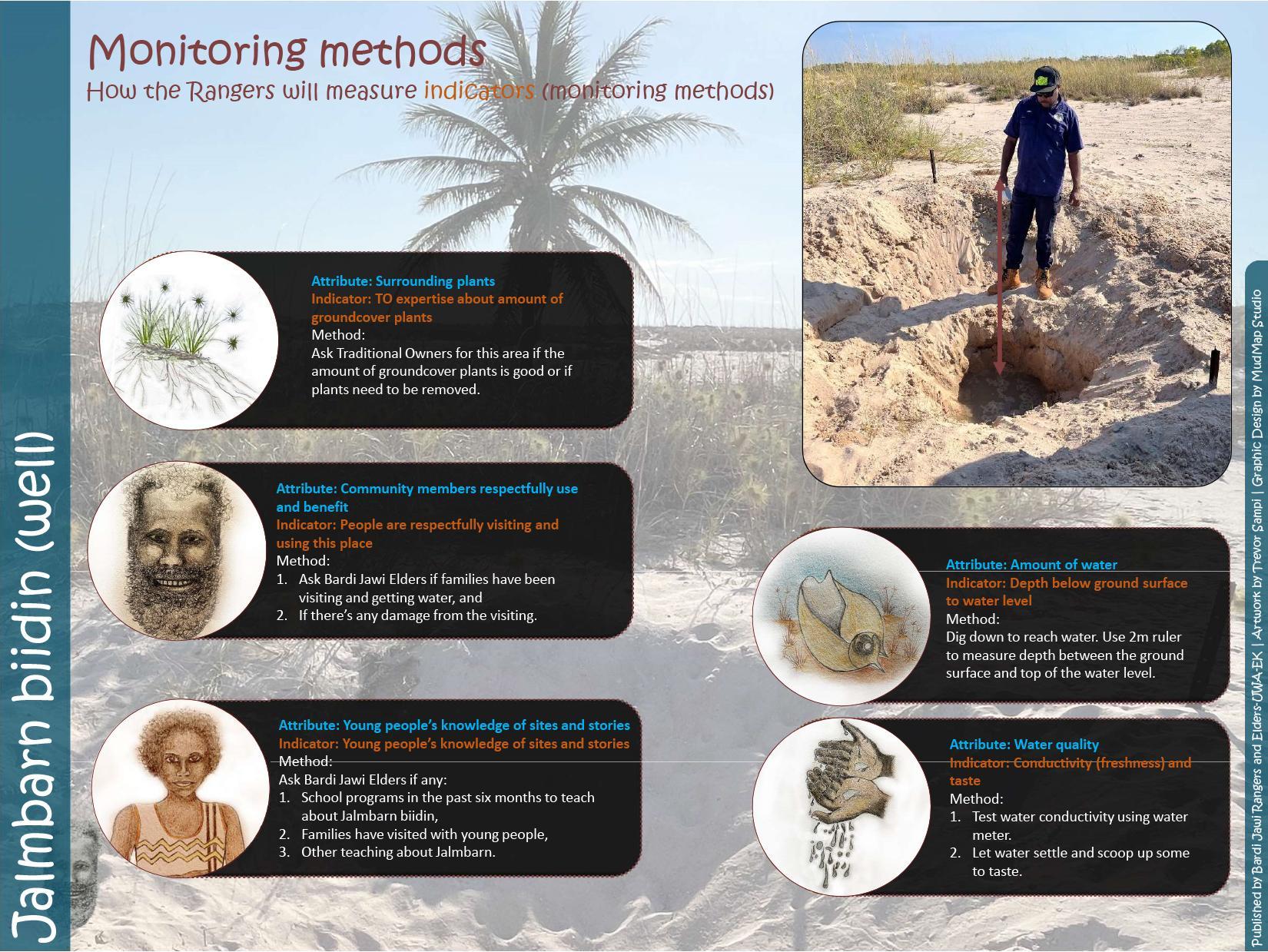
The third poster summarises the monitoring for that place linking the attribute (blue text), indicator (orange text) and monitoring method (white text).
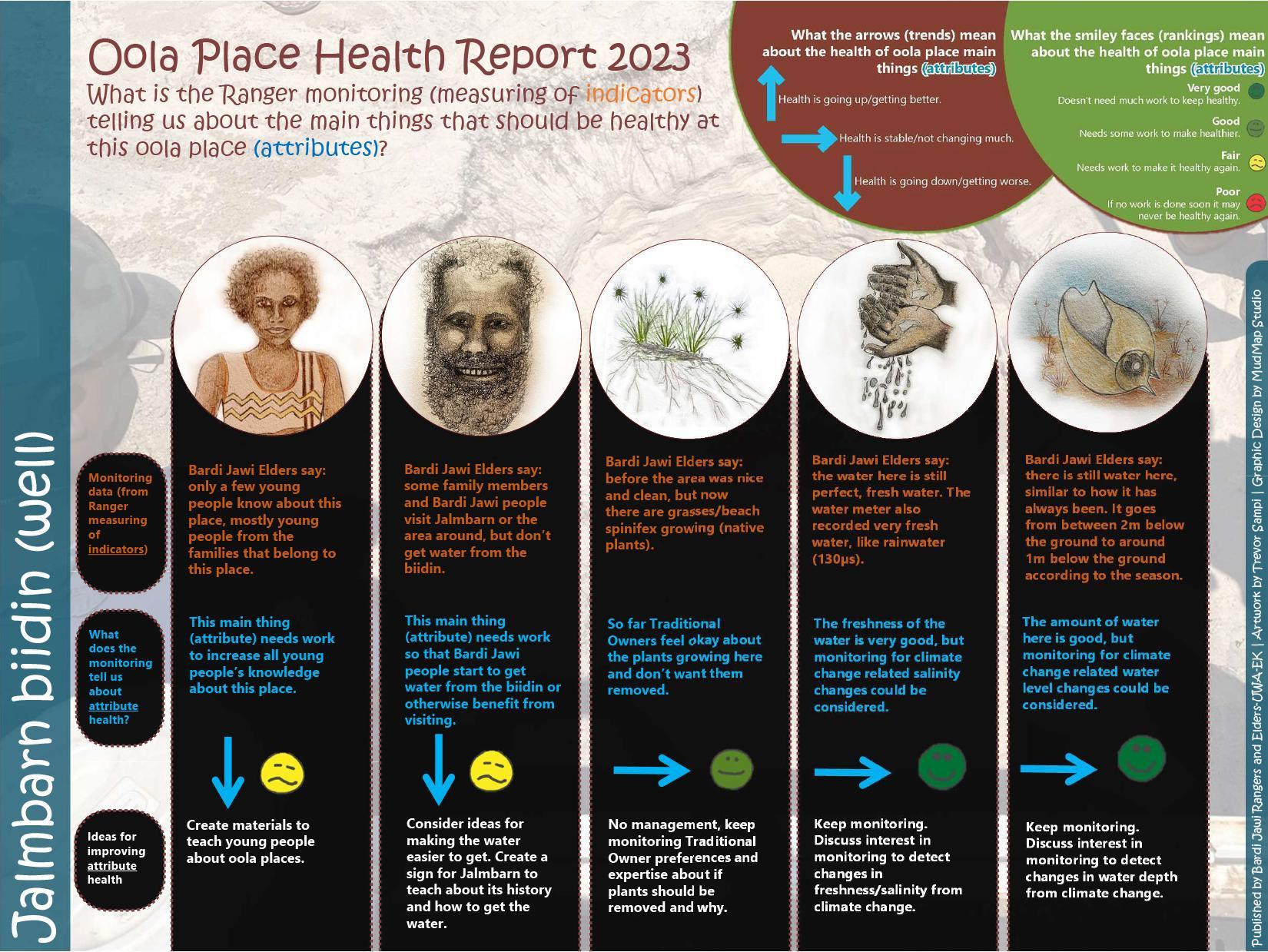
The fourth poster is an overall ‘report card’ for the calendar year, with space to summarise information about indicators collected from the twice-yearly monitoring (orange text) and what this means about attribute condition (blue text). Trend lines (arrows) and smiley faces (rankings) further summarise and visually show attribute condition and trend (with these symbols adopted from the Healthy Country Planning guide). Also included are ideas for management activities (white text – contributed by participating Traditional Owners or advice from collaborators, to be discussed with and considered by the ranger team). The posters are in PowerPoint format, meaning text is easily added, and this poster acts as a template to create a new report card for 2024.